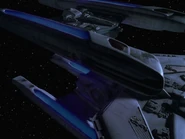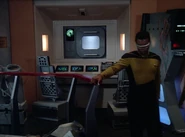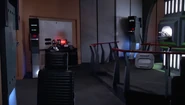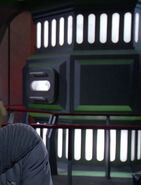m (→Background information: finetuning) |
(→Ships commissioned: USS Gettysburg has the registry of NCC-3890 according to the Star Trek The Official Starships Collection, issue 19, page 11.) Tag: VE |
||
| (20 intermediate revisions by 10 users not shown) | |||
| Line 6: | Line 6: | ||
|operator = [[Starfleet]] |
|operator = [[Starfleet]] |
||
|Type = [[Star cruiser]] |
|Type = [[Star cruiser]] |
||
| − | |Active = [[2280s]]-[[ |
+ | |Active = [[2280s]]-[[2370s]] |
|Speed = [[Warp factor|Warp 9]] (maximum) |
|Speed = [[Warp factor|Warp 9]] (maximum) |
||
|Armament = [[Phaser]]s, [[photon torpedo]]es |
|Armament = [[Phaser]]s, [[photon torpedo]]es |
||
| Line 15: | Line 15: | ||
|imagecap3 = Aft view |
|imagecap3 = Aft view |
||
}} |
}} |
||
| − | The '''''Constellation''-class''' [[starship]] was a type of [[Federation]] [[star cruiser]] employed by [[Starfleet]] from the late [[23rd century]] through the |
+ | The '''''Constellation''-class''' [[starship]] was a type of [[Federation]] [[star cruiser]] employed by [[Starfleet]] from the late [[23rd century]] through the late [[24th century]]. |
== History == |
== History == |
||
| Line 26: | Line 26: | ||
By the mid-[[2360s]], this class of "old-style" [[star cruiser]] was on the fringe of being phased out of the fleet. Those that had been decommissioned, including the eighty-year-old ''Hathaway'', were stripped of their offensive systems and rendered "warp inactive," which included the removal of all [[antimatter]]. ({{TNG|Peak Performance}}) |
By the mid-[[2360s]], this class of "old-style" [[star cruiser]] was on the fringe of being phased out of the fleet. Those that had been decommissioned, including the eighty-year-old ''Hathaway'', were stripped of their offensive systems and rendered "warp inactive," which included the removal of all [[antimatter]]. ({{TNG|Peak Performance}}) |
||
| − | Those that remained in service were typically relegated to [[transport]] duties. ({{TNG|Elementary, Dear Data |
+ | Those that remained in service were typically relegated to [[transport]] duties. ({{TNG|Elementary, Dear Data}}) ''Constellation''-class starships were also used in second-line service, including the hastily-organized Federation [[blockade]] during the [[Klingon Civil War]]. ({{TNG|Redemption II}}) |
| − | In [[2369]], commander of the {{ |
+ | In [[2369]], commander of the {{Class|Galaxy}} {{USS|Enterprise|NCC-1701-D|-D}}, [[Captain]] [[Jean-Luc Picard]], regarded his former command, the ''Constellation''-class USS ''Stargazer'' as being "''an overworked, underpowered vessel that was always on the verge of flying apart at the seams,''" adding, "''in every measurable way, my ''Enterprise'' is a superior ship.''" However, he did admit that there were days when he would've done anything to be back aboard the ''Stargazer''. ({{TNG|Relics}}) |
== Technical data == |
== Technical data == |
||
| Line 39: | Line 39: | ||
|} |
|} |
||
| − | One notable feature of the ''Constellation''-class was that it was one of the few classes in use mounted with four [[Nacelle|warp nacelle]]s. This unique arrangement in a starship design was later found in one of the {{ |
+ | One notable feature of the ''Constellation''-class was that it was one of the few classes in use mounted with four [[Nacelle|warp nacelle]]s. This unique arrangement in a starship design was later found in one of the {{Class|Nebula}} [[:File:USS Melbourne-dedication model.jpg|variants]], as well as the {{Class|Cheyenne}} and {{Class|Prometheus}}es. ({{TNG|The Best of Both Worlds, Part II}}; {{VOY|Message in a Bottle}}) The ''Constellation''-class had a maximum speed of [[warp factor|warp 9]]. ({{TNG|The Battle}}) |
| − | During their original construction, ''Constellation''-class starships employed [[Avidyne engine]]s. By the latter 24th century these had been replaced with more effective engines. ({{TNG|Peak Performance}}) |
+ | During their original construction, ''Constellation''-class starships employed [[Avidyne engine]]s. By the latter 24th century these had been replaced with more effective engines. ({{TNG|Peak Performance}}) These starships had at least two [[impulse reactor]]s. ({{TNG|The Battle}}, ''remastered'') |
{{clear}} |
{{clear}} |
||
| Line 48: | Line 48: | ||
[[File:USS Stargazer, viewscreen.jpg|thumb|Main [[viewscreen]]]] |
[[File:USS Stargazer, viewscreen.jpg|thumb|Main [[viewscreen]]]] |
||
Although the layout of the [[main bridge]] of the ''Constellation''-class of starships could be described as "standard" in terms of how [[Federation]] starship bridges are designed, the ''Constellation''-class appeared to have two prominently different bridge types. These variations can be recognized between the {{USS|Hathaway}}, launched in [[2285]], and the {{USS|Stargazer}}, last active in [[2355]]. |
Although the layout of the [[main bridge]] of the ''Constellation''-class of starships could be described as "standard" in terms of how [[Federation]] starship bridges are designed, the ''Constellation''-class appeared to have two prominently different bridge types. These variations can be recognized between the {{USS|Hathaway}}, launched in [[2285]], and the {{USS|Stargazer}}, last active in [[2355]]. |
||
| − | {{bginfo|Ultimately, both bridge sets were redresses of the {{ |
+ | {{bginfo|Ultimately, both bridge sets were redresses of the {{Class|Galaxy}} [[battle bridge]], ({{TNG|Encounter at Farpoint}}) which was, in turn, a redress of the {{Class|Constitution}} main bridge. ({{film|1}})}} |
[[File:USS Hathaway_bridge.jpg|thumb|Bridge of the {{USS|Hathaway}}]] |
[[File:USS Hathaway_bridge.jpg|thumb|Bridge of the {{USS|Hathaway}}]] |
||
| Line 58: | Line 58: | ||
[[File:USS_Stargazer_bridge1.jpg|thumb|Bridge of the {{USS|Stargazer}}]] |
[[File:USS_Stargazer_bridge1.jpg|thumb|Bridge of the {{USS|Stargazer}}]] |
||
| − | Described as a "cramped little bridge" by [[Jean-Luc Picard|Picard]], the ''Stargazer''-type was actually less cluttered than the ''Hathaway''-type, with a design more reminiscent of the refit {{ |
+ | Described as a "cramped little bridge" by [[Jean-Luc Picard|Picard]], the ''Stargazer''-type was actually less cluttered than the ''Hathaway''-type, with a design more reminiscent of the refit {{Class|Constitution}} or {{Class|Ambassador}} bridge. ({{TNG|Relics}}) |
{{bginfo|Considering the more updated look of the ''Hathaway'' bridge, it may be surmised that the ''Constellation''-class may have undergone a bridge upgrade in the early 24th century, similar to the ''Constitution''-class bridge upgrades of the [[2270s]].}} |
{{bginfo|Considering the more updated look of the ''Hathaway'' bridge, it may be surmised that the ''Constellation''-class may have undergone a bridge upgrade in the early 24th century, similar to the ''Constitution''-class bridge upgrades of the [[2270s]].}} |
||
| Line 82: | Line 82: | ||
== Ships commissioned == |
== Ships commissioned == |
||
;Named: |
;Named: |
||
| − | *{{USS|Constellation| |
+ | *{{USS|Constellation|NX-1974}} (NX-1974) |
*{{USS|Hathaway}} (NCC-2593) |
*{{USS|Hathaway}} (NCC-2593) |
||
*{{USS|Stargazer}} (NCC-2893) |
*{{USS|Stargazer}} (NCC-2893) |
||
*{{USS|Victory}} (NCC-9754) |
*{{USS|Victory}} (NCC-9754) |
||
| ⚫ | |||
;Unnamed: |
;Unnamed: |
||
| Line 92: | Line 93: | ||
;Uncertain: |
;Uncertain: |
||
*{{USS|Magellan}} |
*{{USS|Magellan}} |
||
| ⚫ | |||
== Appendices == |
== Appendices == |
||
| Line 103: | Line 103: | ||
=== Background information === |
=== Background information === |
||
| − | The first ''Constellation''-class ship seen, the ''Stargazer'', was originally planned to be a {{ |
+ | The first ''Constellation''-class ship seen, the ''Stargazer'', was originally planned to be a {{Class|Constitution}} ship, allowing the visual effects staff of ''[[Star Trek: The Next Generation]]'' to make use of the existing movie {{USS|Enterprise|NCC-1701-A|-A}} model. |
==== Studio model ==== |
==== Studio model ==== |
||
| + | :''see main article'': [[Constellation class model]] |
||
| − | The ''Constellation''-class was created before ''[[Star Trek: The Next Generation]]'' began shooting. The need arose in pre-production from the desire to have Picard's ready room dressed with some set pieces, amongst others, a desktop model of his previous command as mentioned in the The Writer's Bible for the show or as Sternbach recalled,"''Andy Probert and I began fleshing out the Stargazer during the preproduction phase of Star Trek: The Next Generation, based on a mention of Captain Picard’s previous command in the TNG writer’s bible. We likely had some words with set decorator John Dwyer about a model of the ship for Picard’s ready room, along with the collaborative painting of the Galaxy class Enterprise to fill up a big empty spot over the sofa. Probert and I discussed the general configuration of the Stargazer, did a number of quick pencil and marker doodles of the major assemblies, and settled on using four nacelles to suggest that the Stargazer was a fast science vessel. Kitbashing the display model could have made use of the plastic parts from a couple of Original Series Enterprise hobby kits, but the historical era could have a bit too old. I don’t believe a kit of the Excelsior class, eventually to become the Enterprise-B, had been released by that time, so we got to work playing with pieces from two NCC-1701 Refit kits.''"[http://drexfiles.wordpress.com/2009/01/11/stargazer-kitbash-pictorial/] |
||
| − | =====Desktop model===== |
||
| − | [[File:NCC-7100, Man of the people.jpg|thumb|3/4 aft view of the model.]] |
||
| − | [[File:NCC-7100.jpg|thumb|left|3/4 front view of the model.]] |
||
| − | The [[model]] was designed by [[Andrew Probert]] and [[Rick Sternbach]], the latter also being the one who constructed the model. The model was mostly kit-bashed from commercially available ''Enterprise''-refit modelkits augmented with custom made parts from styrene sheets (for the enlarged saucer section). According to Sternbach, the desktop model was further detailed with several {{w|anime}} kits from ''{{w|The Super Dimension Fortress Macross}}'', ''{{w|The Super Dimension Century Orguss}}'', ''{{w|Gundam}}'', and ''{{w|Crusher Joe}}''. The largest of these model kit details were the wings and wing box assemblies of a {{w|VF-1 Valkyrie}} model kit from Macross. The desktop model was finished in a dark desert yellow with blue accents and could indeed been seen as a desktop model in Picard's ready room in numerous episodes of the show. A registry number [[NCC-7100]] was applied to the model, but no name, possibly indicating a generic model of the class [http://drexfiles.wordpress.com/2009/01/11/stargazer-kitbash-pictorial/]. |
||
| − | |||
| − | The model first appeared in "Encounter at Farpoint" and, ironically, was absent during the first official appearance of a ''Constellation''-class ship in "The Battle", replaced with a model of a modified [[refit]]-''Constitution''-class ship, as the USS ''Stargazer'' was originally intended to be a member of that class. Probert and Sternbach later persuaded the producers to build a new miniature for the ''Stargazer'' and the desktop model remained missing for additional episodes as it was needed for reference during the construction of the motion-control model. This later four-foot (120 cm) shooting model used parts tooled from scratch to replicate the model kit parts used in the desktop model, with the exception of the VF-1 Valkyrie parts, since equivalent parts were found from a larger-scale kit. |
||
| − | |||
| − | The yellow model's registry was accomplished by rearranging the "NCC-1700" registry decal available in the Constitution-class models. In reality, the registry numbers intended for use on the Constellation type vessels might have been that high, but the number NCC-2893 had already been used on the ship's plaque from the script (although at that time the ship was intended to be a refitted Constitution). |
||
| − | |||
| − | Portions of the ''[[Star Trek: The Next Generation Technical Manual]]'', co-written by the designers/builders who worked on the model itself, include descriptions of starship prototype phases when new ships are painted with a yellow overcoat to reveal warp field stresses. Sternbach, who built the model, later commented on the color, "''The yellow color harmonized with the overall scheme for the ready room, and could be rationalized in a pinch as being a specialized hull coating used in initial warp field tests. Yeah, that’s the ticket.''"[http://drexfiles.wordpress.com/2009/01/11/stargazer-kitbash-pictorial/] Some fans have interpreted that Picard keeps the model because the starship NCC-7100's test flight was important to him in some way. |
||
| − | |||
| − | Rick Sternback's perspective on the model, from the Drex Files, "''It's like Camelot, it's only a model. Pretend the NCC-7100 isn't there, and it's exactly like a corporate desk model of, say, an F-22 with generic markings and no specific tail number. Yes, the model represents the USS Stargazer, and if we knew back in early 1987 what the actual reg number would turn out to be, we would have used that. Just keep saying: 'There is no 7100... there is no 7100'.''" [http://drexfiles.wordpress.com/2009/01/11/stargazer-kitbash-pictorial/#comment-336] |
||
| − | |||
| − | This starship was still referred to as the Stargazer by some members of the writing staff, notably in the script for "Chain of Command, Part I". |
||
| − | |||
| − | Interestingly, the very first commercially available model of this class, the gaming miniature sized micro machine from [[Galoob]], was in this color scheme although given the name and registry number of the ''Stargazer'', the producers probably being confused by early publicized photos. |
||
| − | =====Filming model===== |
||
| − | The producers did not make the decision to build a full scale [[Studio_model#Studio_model|filming model]] of the ''Stargazer'' until after the episode was filmed with both [[Wil Wheaton]] and [[LeVar Burton]] calling it a ''Constitution''. The choice of the name "Constellation" was based largely on the fact that it could be dubbed over La Forge's line since the two words are so similar. The task of building the full scale, four-foot, model fell to [[Gregory Jein]], using the equivalent parts from a larger-scale VF-1 Valkyrie kit.[http://groups.google.com/group/alt.sf.scale-models/browse_frm/thread/31e9512ecb8bb189/15ccfbb747308334?lnk=st&q=sternbach+valkyrie&rnum=6#15ccfbb747308334] [http://groups.google.com/group/alt.sf.scale-models/browse_frm/thread/85a02adde4fa066b/3c2e76a01e2c4b9a?lnk=st&q=sternbach+valkyrie&rnum=9#3c2e76a01e2c4b9a]. The ''Stargazer'' was the first new ''starship'' design seen by audiences since the introduction of the ''Enterprise-D ''and would remain so until the introduction of the {{ShipClass|Ambassador}} in third season's {{e|Yesterday's Enterprise}}. |
||
| − | |||
| − | The model was eventually labeled the USS ''Valkyrie'' (an in-joke of the production staff, as it referred to the ''Valkyrie'' parts they used in constructing the model) for tour displays such as ''[[Star Trek World Tour]]'', ''[[Star Trek: The Exhibition]]'' and ''[[Star Trek: The Adventure]]'', complete with the [[registry]] NCC-2590 [http://drexfiles.files.wordpress.com/2009/01/valkyrie.jpg] and has probably been more on tour than any other model, since its use as a production asset was played out early on. The faded name {{USS|Hathaway}} has been observed on this model underneath the ''Valkyrie'' decal, the only time the vessel was relabeled (later appearances being stock footage). |
||
| − | |||
| − | As per 2009, the studio model itself, having escaped the [[40 Years of Star Trek: The Collection]] and [[It's A Wrap! sale and auction]] -auctions, is still in the possession of [[Paramount Pictures]] and has been on tour as late as 2008.[http://startrekpropauthority.blogspot.com/2009/04/star-trek-exhibition-in-detroit_20.html] |
||
| − | =====CGI model===== |
||
| − | Since the ''Constellation''-class has already been considered an obsolete vessel in the early ''TNG''-era, no [[CGI]] model was ever constructed for live-action production purposes and has therefore not been visually present in any of the other ''Star Trek'' series. |
||
| − | |||
| − | Still, a CGI model was eventually constructed by [[Doug Drexler]], when he was asked to do the cover for [[Michael Jan Friedman]]'s (licensed) novel [[Enigma]] in 2004. Drexler remembered on his blog,"''Usually covers like this don’t come with a lot of lead time, and the budget does not provide for building models, so I set to work converting the Directors Cut TMP CG Enterprise. Margaret Clark had spotted a cover of a novel that showed a WWII Hellcat dive bomber double exposed over the ocean blended with a map. She sparked to that and thought it was just the thing to hang the “Enigma” cover on. I grabbed a starmap that I had been admiring which Alan Kobayashi had made for Mike to hang in Captain Archer’s cabin. That was the cover, and a real nice one too! Someone wrote me a note asking if I could run some Stargazer orthos. I had never made any for the blog because it was such a quickie kitbash, I figured it wouldn’t hold up.''"[http://drexfiles.wordpress.com/2011/02/06/stargazer-a-kitbash-great/comment-page-1/#comment-28896] Missing some of the details found on the physical models (especially on the ventral side), the CGI version found its way on other licensed products such as the ''[[Ships of the Line]]'' book and ''[[Star Trek: Ships of the Line (2005)]]'' calendar.[http://drexfiles.wordpress.com/2009/07/07/14607/] |
||
==== The Magazine ==== |
==== The Magazine ==== |
||
An [[Starfleet Technical Database]]-article appearing in [[Star Trek: The Magazine Volume 3, Issue 9]] that was later written by designer-creator Rick Sternbach stated that this class of ship had fifteen decks and a crew complement of 535 and that the class consisted of eight vessels (including the USS ''Gettysburg'' and USS ''Magellan''). In addition to the aforementioned, the article also stated that a USS ''Valkyrie'' (NCC 2590) and a USS ''Gihlan'' (NCC-9761) existed, the latter named after an admiral who oversaw the development of ''Constellation''-class starships. The class's mission statements were: long-range sensor analysis within threat territories, communications, intelligence gathering, deployment and retrieval of cargo and stealth shuttles, general science and patrol duties. |
An [[Starfleet Technical Database]]-article appearing in [[Star Trek: The Magazine Volume 3, Issue 9]] that was later written by designer-creator Rick Sternbach stated that this class of ship had fifteen decks and a crew complement of 535 and that the class consisted of eight vessels (including the USS ''Gettysburg'' and USS ''Magellan''). In addition to the aforementioned, the article also stated that a USS ''Valkyrie'' (NCC 2590) and a USS ''Gihlan'' (NCC-9761) existed, the latter named after an admiral who oversaw the development of ''Constellation''-class starships. The class's mission statements were: long-range sensor analysis within threat territories, communications, intelligence gathering, deployment and retrieval of cargo and stealth shuttles, general science and patrol duties. |
||
| − | |||
| − | ==== Apocrpyha ==== |
||
| − | [[File:Stargazer.jpg|thumb|USS ''Stargazer'' (NCC-2893-A) in ''Star Trek Online'']] |
||
| − | In ''[[Star Trek Online]]'', the ''Stargazer''-class features as a playable ship in the "Heavy Cuiser" tier. The class has been redesigned to have the [[warp nacelle]]s wider apart than the original, and features a slight curve on the originally straight incline on the main hull. |
||
=== External links === |
=== External links === |
||
* {{NCwiki|Constellation class}} |
* {{NCwiki|Constellation class}} |
||
| − | * {{wikipedia|Constellation class starship}} |
+ | * {{wikipedia|List of Starfleet starships ordered by class#Constellation class|Constellation class starship}} |
Revision as of 10:56, 19 December 2014
The Constellation-class starship was a type of Federation star cruiser employed by Starfleet from the late 23rd century through the late 24th century.
History
The Constellation-class began service as early as 2285, when at least one such ship, the USS Hathaway, was constructed by Yoyodyne Propulsion Systems at the Copernicus Ship Yards on Luna. (USS Hathaway dedication plaque)
Nearly a decade after the launch of the Hathaway, the prototype for the class, the USS Constellation, was still undergoing certification trials. (Star Trek VI: The Undiscovered Country Operation Retrieve chart)
During the early 24th century, the Constellation-class was noted for performing both deep-space exploration and defensive patrol duties. (TNG: "The Battle", "The Wounded")
By the mid-2360s, this class of "old-style" star cruiser was on the fringe of being phased out of the fleet. Those that had been decommissioned, including the eighty-year-old Hathaway, were stripped of their offensive systems and rendered "warp inactive," which included the removal of all antimatter. (TNG: "Peak Performance")
Those that remained in service were typically relegated to transport duties. (TNG: "Elementary, Dear Data") Constellation-class starships were also used in second-line service, including the hastily-organized Federation blockade during the Klingon Civil War. (TNG: "Redemption II")
In 2369, commander of the Galaxy-class USS Enterprise-D, Captain Jean-Luc Picard, regarded his former command, the Constellation-class USS Stargazer as being "an overworked, underpowered vessel that was always on the verge of flying apart at the seams," adding, "in every measurable way, my Enterprise is a superior ship." However, he did admit that there were days when he would've done anything to be back aboard the Stargazer. (TNG: "Relics")
Technical data
Propulsion systems
Closeup view of nacelles |
One notable feature of the Constellation-class was that it was one of the few classes in use mounted with four warp nacelles. This unique arrangement in a starship design was later found in one of the Nebula-class variants, as well as the Cheyenne-class and Prometheus-classes. (TNG: "The Best of Both Worlds, Part II"; VOY: "Message in a Bottle") The Constellation-class had a maximum speed of warp 9. (TNG: "The Battle")
During their original construction, Constellation-class starships employed Avidyne engines. By the latter 24th century these had been replaced with more effective engines. (TNG: "Peak Performance") These starships had at least two impulse reactors. (TNG: "The Battle", remastered)
Interior design
Main bridge
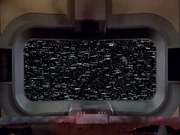
Main viewscreen
Although the layout of the main bridge of the Constellation-class of starships could be described as "standard" in terms of how Federation starship bridges are designed, the Constellation-class appeared to have two prominently different bridge types. These variations can be recognized between the USS Hathaway, launched in 2285, and the USS Stargazer, last active in 2355.
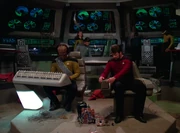
Bridge of the USS Hathaway
The Hathaway-type bridge had an unusual arrangement, with front of the bridge relatively wide open and the primary stations cramped in the rear of the bridge.
The helm and navigation stations were located on the extreme port and starboard sides of the ship with the captain's chair near the center of the bridge. This gave the captain an unobstructed view of the viewscreen located at the front of the bridge. Next to the captain's chair, set less than a meter back and off to the right, was the first officer's chair with console.
Directly behind the command chairs was the tactical station, with the engineering station to the far rear (on the port side) and science station to the far rear (starboard side). In front of the engineering station was an entryway to the bridge entryway. (TNG: "Peak Performance")

Bridge of the USS Stargazer
Described as a "cramped little bridge" by Picard, the Stargazer-type was actually less cluttered than the Hathaway-type, with a design more reminiscent of the refit Constitution-class or Ambassador-class bridge. (TNG: "Relics")
In the front was the viewscreen, with side-by-side helm and navigator consoles, a feature that noticeably contrasts that of the Hathaway-type. The captain's chair was directly aft the aforementioned stations; no accommodations were present for the first officer in this type.
At the rear of the bridge, a tactical station was found on the far left with monitors along the back wall behind the captain's chair, with a second primary station located on the opposite side of the bridge. The primary stations were attached to the rear wall of the bridge; support railing partially enclosed that section from the front of the bridge. On either side of the rear wall monitors and between either primary station were two turbolifts. Along the port wall, directly to the left of the captain's chair and between the tactical station and the viewscreen, was the entryway to the captain's ready room. (TNG: "The Battle")
Main engineering
Main engineering was where the ship's power systems were controlled and was the home of the ship's antimatter warp drive chamber and impulse engine controls. (TNG: "Peak Performance")
Crew cabins
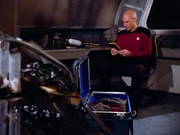
Picard's quarters
Cabins aboard Constellation-class starships were of typical design associated with Federation starship of the era, providing spartan accommodations for the crew. (TNG: "The Battle")
Ships commissioned
- Named
- USS Constellation (NX-1974)
- USS Hathaway (NCC-2593)
- USS Stargazer (NCC-2893)
- USS Victory (NCC-9754)
- USS Gettysburg (NCC-3890)
- Unnamed
- Uncertain
Appendices
Appearances
Background information
The first Constellation-class ship seen, the Stargazer, was originally planned to be a Constitution-class ship, allowing the visual effects staff of Star Trek: The Next Generation to make use of the existing movie USS Enterprise-A model.
Studio model
- see main article: Constellation class model
The Magazine
An Starfleet Technical Database-article appearing in Star Trek: The Magazine Volume 3, Issue 9 that was later written by designer-creator Rick Sternbach stated that this class of ship had fifteen decks and a crew complement of 535 and that the class consisted of eight vessels (including the USS Gettysburg and USS Magellan). In addition to the aforementioned, the article also stated that a USS Valkyrie (NCC 2590) and a USS Gihlan (NCC-9761) existed, the latter named after an admiral who oversaw the development of Constellation-class starships. The class's mission statements were: long-range sensor analysis within threat territories, communications, intelligence gathering, deployment and retrieval of cargo and stealth shuttles, general science and patrol duties.
External links
- Template:NCwiki
- Constellation class starship at Wikipedia

